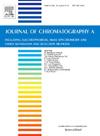用逐步梯度反相液相色谱法分馏木质素低聚物
IF 3.8
2区 化学
Q1 BIOCHEMICAL RESEARCH METHODS
引用次数: 0
摘要
随着人们对木质素价值化的兴趣与日俱增,分离由大量酚类化合物组成的复杂混合物所带来的分析挑战使色谱法成为木质素分析中不可或缺的步骤。气相色谱法、反相液相色谱法和超临界流体色谱法等高分辨率分离法通常以低分子量化合物为目标,而较大的木质素低聚物则较少受到关注。由于木质素高分子量部分的固有复杂性,这些化合物已被证明难以分离,事实上,即使是高分辨线性反相梯度也会将它们洗脱为一个宽阔的区域。为了解决这个问题,我们在本研究中展示了通过使用阶跃反相梯度可以实现木质素低聚物的粗分馏。为完成这一任务,我们对常用的以水:乙腈为流动相的反相系统进行了评估。我们特别注意从分子水平上解释保留现象。我们的结果表明,分离主要受反相保留现象的支配,没有任何主要的排斥或粘度相关影响,这表现在线性保留模型的高度拟合(5 种不同低聚物的 R2avg = 0.9599)以及不同固定相之间保留率的明显差异。通过比较不同步数和频率的阶梯梯度,证明了梯度形状的影响,从而得出结论:低步数梯度产生的馏分较少,但分辨效果更好,而更精细的多步梯度可用于分辨更多馏分。本文章由计算机程序翻译,如有差异,请以英文原文为准。
On the fractionation of lignin oligomers by stepwise gradient reversed-phase liquid chromatography
With the increased interest in lignin valorization, the analytical challenge to separate a complex mixture of a vast number of phenolics has made chromatography an indispensable step in lignin analysis. High-resolution separations, such as gas chromatography, reversed-phase liquid chromatography and supercritical fluid chromatography have typically been targeting low-molecular-weight compounds, while larger lignin oligomers have received less attention. These compounds have proven to be difficult to separate due to the inherent complexity of the high-molecular-weight fraction of lignins, in fact, even high-resolving linear reversed-phase gradients elute them as one wide zone. To tackle this, in this study we show that a crude fractionation of lignin oligomers can be achieved by applying stepwise reversed-phase gradients. A commonly employed reversed-phase system with water:acetonitrile mobile phase is evaluated for this task. Special attention was devoted to uncovering the molecular level explanation of the retention phenomenon. Our results indicate that separation is mainly governed by reversed-phase retention phenomena without any major exclusion or viscosity-related effects, shown by great fits to linear retention models (R2avg = 0.9599 for five different oligomers) and apparent differences in retentivity between different stationary phases. The influence of the gradient shape was demonstrated by the comparison of stepwise gradients with different number and frequency of steps, leading to the conclusion that gradients with a low number of steps yield fewer, but better resolved fractions, while finer multi-step gradients can be used to distinguish more fractions.
求助全文
通过发布文献求助,成功后即可免费获取论文全文。
去求助
来源期刊

Journal of Chromatography A
化学-分析化学
CiteScore
7.90
自引率
14.60%
发文量
742
审稿时长
45 days
期刊介绍:
The Journal of Chromatography A provides a forum for the publication of original research and critical reviews on all aspects of fundamental and applied separation science. The scope of the journal includes chromatography and related techniques, electromigration techniques (e.g. electrophoresis, electrochromatography), hyphenated and other multi-dimensional techniques, sample preparation, and detection methods such as mass spectrometry. Contributions consist mainly of research papers dealing with the theory of separation methods, instrumental developments and analytical and preparative applications of general interest.
 求助内容:
求助内容: 应助结果提醒方式:
应助结果提醒方式:


